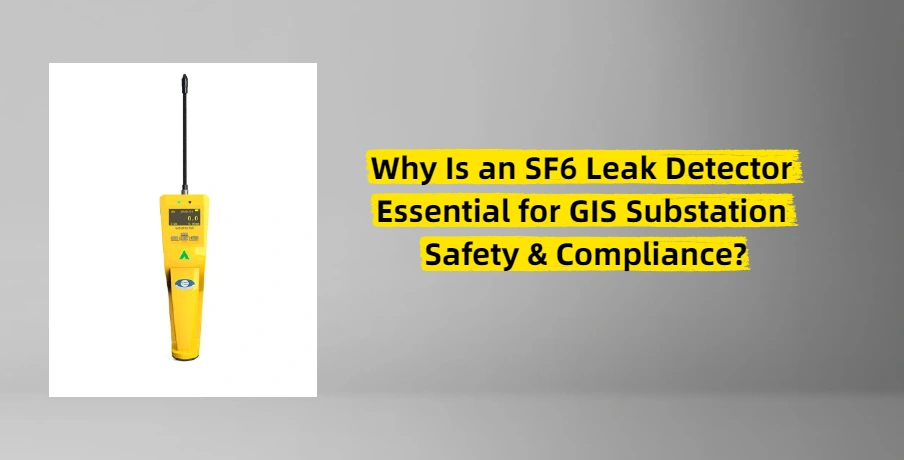
Why Is an SF6 Leak Detector Essential for GIS Substation Safety & Compliance?
GIS (Gas-Insulated Switchgear) substations are the backbone of modern power grids, relying on sulfur hexafluoride (SF6) gas for superior insulation and arc-quenching performance. However, SF6 is a potent greenhouse gas—with a global warming potential (GWP) 23,500 times that of CO₂—and even minor leaks can compromise equipment safety, increase operational costs, and harm the environment. This is where an efficient SF6 leak detector for GIS substation becomes indispensable. Below is a comprehensive guide to understanding its role, key features, selection, and application.
Why SF6 Leak Detection Is Non-Negotiable for GIS Substations
SF6 gas is critical to GIS substation functionality: it enables compact equipment design (reducing footprint by up to 90% vs. air-insulated switchgear) and ensures reliable operation in harsh conditions (humidity, dust, extreme temperatures). But leaks—often caused by worn seals, loose fittings, or material degradation—pose severe risks:
- Equipment Failure: Low SF6 pressure weakens insulation, leading to arcing, short circuits, or even catastrophic breakdowns.
- High Costs: SF6 is expensive; a single small leak can cost thousands in gas refills annually.
- Environmental Non-Compliance: Global regulations (e.g., EU F-Gas Regulation, EPA rules) mandate strict SF6 emission controls, with penalties for non-compliance.
A dedicated SF6 leak detector for GIS substation addresses these risks by identifying leaks early, allowing timely repairs and minimizing losses.
Key Features of a High-Performance SF6 Leak Detector for GIS Substations
Not all SF6 leak detectors are designed for GIS environments—substations demand tools that withstand tough conditions while delivering accuracy. Look for these critical features:
- High Detection Sensitivity: GIS leaks are often micro-sized (as low as 1 x 10⁻⁶ mL/s). Opt for detectors with sensitivity down to 0.1 ppm (parts per million) to catch even tiny leaks.
- Fast Response Time: Delays in leak detection increase risks. Top models offer response times <1 second, ensuring quick identification during inspections.
- Portability & Durability: GIS substations have tight spaces and outdoor areas. Choose a handheld, rugged detector (IP65 or higher ingress protection) that resists dust, moisture, and vibrations.
- GIS-Specific Compatibility: Ensure the detector works with SF6’s chemical properties and can access hard-to-reach points (e.g., flange connections, valve seals) via flexible probes.
- Data Logging & Connectivity: Modern detectors include Bluetooth/Wi-Fi for real-time data sharing (to cloud platforms or maintenance software), simplifying record-keeping for compliance audits.
How to Select the Right SF6 Leak Detector for Your GIS Substation
Selection should align with your substation’s size, layout, and regulatory requirements. Follow these steps:
- Assess Leak Detection Needs: For large GIS substations with multiple switchgear units, prioritize detectors with extended detection ranges (up to 10 meters) and battery life (8+ hours) for all-day inspections. For indoor GIS, choose models with low noise levels to avoid disrupting operations.
- Verify Compliance: Ensure the detector meets international standards (e.g., IEC 60480 for SF6 handling) and local regulations—this avoids compliance gaps during audits.
- Evaluate Usability: Look for intuitive interfaces (LCD screens, one-button operation) to train staff quickly. Some detectors also offer auto-calibration, reducing maintenance time.
Practical Application of SF6 Leak Detectors in GIS Substations
Effective leak detection follows a structured process:
- Pre-Inspection Preparation: Power down the GIS unit (if safe) and clean surfaces to remove dust—this prevents false positives. Calibrate the detector per the manufacturer’s instructions (typically monthly for high-use units).
- Targeted Detection: Focus on high-risk areas: flange seals, gas valves, pressure gauges, and weld joints. Use the detector’s flexible probe to reach tight spaces, moving it slowly (1–2 cm/s) to avoid missing leaks.
- Data Documentation: Record leak locations, concentration levels, and timestamps. Use the detector’s data logging feature to generate reports for maintenance teams and compliance records.
- Post-Leak Resolution: After repairing leaks, re-test the area to confirm zero emissions. Log the repair details to track long-term leak trends.
Maintenance Tips to Extend Your SF6 Leak Detector’s Lifespan
A well-maintained detector delivers consistent performance:
- Regular Calibration: Calibrate every 6–12 months (or after 500 hours of use) to ensure accuracy. Some manufacturers offer on-site calibration services for convenience.
- Probe Care: Clean the probe after each use with a soft brush; replace worn probes immediately (damaged probes reduce sensitivity).
- Storage: Keep the detector in a dry, temperature-controlled case (10–30°C) when not in use. Avoid exposure to extreme heat or chemicals.
An SF6 leak detector for GIS substation is not just a tool—it’s an investment in power grid safety, cost efficiency, and environmental responsibility. By choosing a detector with the right sensitivity, durability, and compliance features, and following best practices for application and maintenance, you can protect your GIS equipment, reduce emissions, and meet regulatory demands. As power grids grow more complex, prioritizing SF6 leak detection will remain critical to ensuring reliable, sustainable operations.

